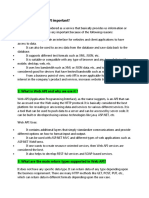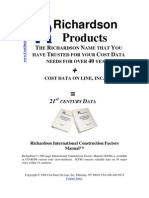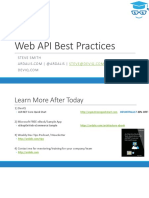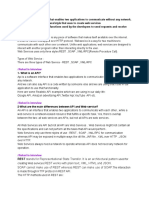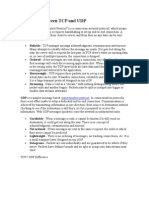0 ratings0% found this document useful (0 votes)
2 viewsWeb API Interview Questions
The document provides a comprehensive overview of 20 key interview questions related to Web APIs, covering topics such as definitions, authentication methods, differences between REST and SOAP, CORS, rate limiting, API gateways, and security practices. It also discusses technical concepts like middleware, versioning, logging, content negotiation, and model binding. Each question is succinctly answered, making it a useful resource for preparing for Web API-related interviews.
Uploaded by
ayushisar110Copyright
© © All Rights Reserved
Available Formats
Download as PDF, TXT or read online on Scribd
0 ratings0% found this document useful (0 votes)
2 viewsWeb API Interview Questions
The document provides a comprehensive overview of 20 key interview questions related to Web APIs, covering topics such as definitions, authentication methods, differences between REST and SOAP, CORS, rate limiting, API gateways, and security practices. It also discusses technical concepts like middleware, versioning, logging, content negotiation, and model binding. Each question is succinctly answered, making it a useful resource for preparing for Web API-related interviews.
Uploaded by
ayushisar110Copyright
© © All Rights Reserved
Available Formats
Download as PDF, TXT or read online on Scribd
You are on page 1/ 9
20 Web API
Interview Question
1. What is a Web API, and why is it used?
A Web API (Application Programming
Interface) allows communication between
client and server over HTTP. It exposes
endpoints for CRUD operations and is
commonly used in web/mobile apps to
interact with backend services.
2. Explain the difference between REST
and SOAP APIs.
• REST: Lightweight, stateless, uses HTTP
verbs, and returns JSON or XML. Easier
to integrate.
• SOAP: Protocol-based, XML-only, has
strict standards and built-in security
(WS-Security).
3. How does authentication work in Web
APIs?
Authentication verifies a user's identity.
Common methods:
• Basic Auth
• Token-based (JWT, OAuth)
• API Keys
4. What is CORS, and why is it important?
CORS (Cross-Origin Resource Sharing) is a
browser mechanism that restricts web
pages from making requests to a different
domain. It must be configured on the server
to allow cross-origin requests.
5. How do you handle rate limiting in Web
APIs?
Rate limiting restricts the number of
requests a client can make in a given time
frame. Techniques:
• Token bucket
• Leaky bucket
• Throttling policies in API Gateways
6. What is an API Gateway, and what role
does it play?
An API Gateway manages and routes client
requests to backend services. It handles:
• Routing
• Authentication
• Rate limiting
• Aggregation
• Monitoring
7. Explain token-based authentication in
Web APIs.
After successful login, the server issues a
token (like JWT). Clients include the token in
headers for subsequent requests. Server
validates the token to authenticate the user.
8. What is Swagger/OpenAPI, and how is
it used?
Swagger/OpenAPI is a specification for
documenting APIs. It allows:
• API exploration
• Auto-generated docs
• Client SDK generation
• Testing endpoints
9. How do you secure a Web API?
• Use HTTPS
• Implement authentication/authorization
• Input validation
• CORS configuration
• Rate limiting
• Security headers (e.g., CSP, HSTS)
10. What is dependency injection in Web
API development?
Dependency Injection (DI) is a design
pattern where dependencies (services,
repositories) are injected into a class rather
than being created internally. Promotes
testability and loose coupling.
11. How does versioning work in Web
APIs?
Common versioning strategies:
• URL (e.g., /api/v1/products)
• Query string (e.g., ?version=1)
• Header (e.g., Accept:
application/vnd.company.v1+json)
12. Explain middleware in ASP.NET Web
API.
Middleware components process HTTP
requests and responses. They can be
chained together to add features like
logging, authentication, and error handling.
13. What is the difference between
synchronous and asynchronous API
calls?
• Synchronous: Blocks execution until
the task is complete.
• Asynchronous: Frees up the thread,
allowing other tasks to run. Improves
scalability and performance.
14. How do you implement logging in Web
APIs?
Use logging libraries like Serilog, NLog, or
built-in ASP.NET Core logging. Log
request/response data, errors, and custom
events for diagnostics and monitoring.
15. What is content negotiation in Web
APIs?
It's the process of selecting the appropriate
response format (JSON, XML, etc.) based
on the Accept header sent by the client.
16. How do you handle exceptions
globally in Web APIs?
Use:
• Exception filters (IExceptionFilter)
• Middleware for centralized error
handling
• Custom error responses/logging
17. What is the difference between
IHttpActionResult and
HttpResponseMessage?
• IHttpActionResult: Introduced in Web
API 2; promotes testability and
abstraction.
• HttpResponseMessage: Gives full
control over the HTTP response.
18. How does attribute routing work in
Web APIs?
You decorate controllers and actions with
[Route("path")] attributes for defining
custom routes instead of relying on default
routing conventions.
19. What is model binding in Web APIs?
Model binding maps incoming HTTP
request data to parameters or objects in
controller methods automatically (from
body, query string, route, etc.).
20. How do you implement file upload in
Web APIs?
Use IFormFile or
MultipartFormDataContent in .NET Core.
The server reads file data from the request
and stores it as needed.
You might also like
- Explain The Ideology of Pakistan in The Light of The Sayings of The Quaid100% (10)Explain The Ideology of Pakistan in The Light of The Sayings of The Quaid5 pages
- Most Asked Web API Interview Questions 2023 JavatpointNo ratings yetMost Asked Web API Interview Questions 2023 Javatpoint2 pages
- Top 20 ASP - NET Web API Interview QuestionsNo ratings yetTop 20 ASP - NET Web API Interview Questions25 pages
- Asp.NET core web APi interview Question and ansNo ratings yetAsp.NET core web APi interview Question and ans21 pages
- EContent 11 2024 05 04 21 41 47 Unit 5 ASPNET Web API and Security1pptx 2024 04 26 09 56 42No ratings yetEContent 11 2024 05 04 21 41 47 Unit 5 ASPNET Web API and Security1pptx 2024 04 26 09 56 4237 pages
- 1-What Is An API?: //asked in InterviewNo ratings yet1-What Is An API?: //asked in Interview10 pages
- EContent_11_2024_12_10_05_37_43_5Unit_5_ASPNET_Web_API_and_Securitypptx__2024_11_20_10_01_15No ratings yetEContent_11_2024_12_10_05_37_43_5Unit_5_ASPNET_Web_API_and_Securitypptx__2024_11_20_10_01_1539 pages
- 7_API testing Interview Questions and AnswersNo ratings yet7_API testing Interview Questions and Answers14 pages
- Full Stack Interview Questions and AnswersNo ratings yetFull Stack Interview Questions and Answers6 pages
- 21 Latest Spring REST Interview QuestionsNo ratings yet21 Latest Spring REST Interview Questions5 pages
- PDF Web Api Interview Questions - CompressNo ratings yetPDF Web Api Interview Questions - Compress32 pages
- The FastAPI Handbook: Simplifying Web Development with PythonFrom EverandThe FastAPI Handbook: Simplifying Web Development with PythonNo ratings yet
- Aprende programación python aplicaciones web: python, #2From EverandAprende programación python aplicaciones web: python, #2No ratings yet
- Complex Network Theory CS60078: Department of Computer Science & Engineering, IIT KharagpurNo ratings yetComplex Network Theory CS60078: Department of Computer Science & Engineering, IIT Kharagpur77 pages
- 8 Different Stitches: Submitted By: Villanueva, Lauren May ONo ratings yet8 Different Stitches: Submitted By: Villanueva, Lauren May O22 pages
- The "Unhappy Consciousness" and Conscious Unhappiness: On Adorno's Critique of Hegel and The Idea of An Hegelian Critique of AdornoNo ratings yetThe "Unhappy Consciousness" and Conscious Unhappiness: On Adorno's Critique of Hegel and The Idea of An Hegelian Critique of Adorno18 pages
- SSC JE Study Materials Civil ESTIMATING COSTING and VALUATION100% (1)SSC JE Study Materials Civil ESTIMATING COSTING and VALUATION20 pages
- Castels How Nation State Respond To Immigration and Ethnic DiversityNo ratings yetCastels How Nation State Respond To Immigration and Ethnic Diversity17 pages
- Oee Y Kpi S: Edson Orbe Sanchez Jorge Emmanuel Orozco Piña Brandon Vega Ventura Luis Ricardo Equipo 7100% (8)Oee Y Kpi S: Edson Orbe Sanchez Jorge Emmanuel Orozco Piña Brandon Vega Ventura Luis Ricardo Equipo 761 pages
- Peter Ludlow - Living Words - Meaning Underdetermination and The Dynamic Lexicon-Oxford University Press (2014)No ratings yetPeter Ludlow - Living Words - Meaning Underdetermination and The Dynamic Lexicon-Oxford University Press (2014)209 pages
- IBM Spectrum Virtualize - BP Zoning 101-Top 10-Part1 HollywoodNo ratings yetIBM Spectrum Virtualize - BP Zoning 101-Top 10-Part1 Hollywood38 pages
- Multiple Choices: C. I Will Give You The Key of This CarNo ratings yetMultiple Choices: C. I Will Give You The Key of This Car12 pages
- Inter Audit MCQ and Case Studies - For Nov. 2023 ExamsNo ratings yetInter Audit MCQ and Case Studies - For Nov. 2023 Exams106 pages
- Verification and Validation of Digital Twins and Virtual TestbedsNo ratings yetVerification and Validation of Digital Twins and Virtual Testbeds18 pages
- Explain The Ideology of Pakistan in The Light of The Sayings of The QuaidExplain The Ideology of Pakistan in The Light of The Sayings of The Quaid
- Most Asked Web API Interview Questions 2023 JavatpointMost Asked Web API Interview Questions 2023 Javatpoint
- EContent 11 2024 05 04 21 41 47 Unit 5 ASPNET Web API and Security1pptx 2024 04 26 09 56 42EContent 11 2024 05 04 21 41 47 Unit 5 ASPNET Web API and Security1pptx 2024 04 26 09 56 42
- EContent_11_2024_12_10_05_37_43_5Unit_5_ASPNET_Web_API_and_Securitypptx__2024_11_20_10_01_15EContent_11_2024_12_10_05_37_43_5Unit_5_ASPNET_Web_API_and_Securitypptx__2024_11_20_10_01_15
- The FastAPI Handbook: Simplifying Web Development with PythonFrom EverandThe FastAPI Handbook: Simplifying Web Development with Python
- Aprende programación python aplicaciones web: python, #2From EverandAprende programación python aplicaciones web: python, #2
- Complex Network Theory CS60078: Department of Computer Science & Engineering, IIT KharagpurComplex Network Theory CS60078: Department of Computer Science & Engineering, IIT Kharagpur
- 8 Different Stitches: Submitted By: Villanueva, Lauren May O8 Different Stitches: Submitted By: Villanueva, Lauren May O
- The "Unhappy Consciousness" and Conscious Unhappiness: On Adorno's Critique of Hegel and The Idea of An Hegelian Critique of AdornoThe "Unhappy Consciousness" and Conscious Unhappiness: On Adorno's Critique of Hegel and The Idea of An Hegelian Critique of Adorno
- SSC JE Study Materials Civil ESTIMATING COSTING and VALUATIONSSC JE Study Materials Civil ESTIMATING COSTING and VALUATION
- Castels How Nation State Respond To Immigration and Ethnic DiversityCastels How Nation State Respond To Immigration and Ethnic Diversity
- Oee Y Kpi S: Edson Orbe Sanchez Jorge Emmanuel Orozco Piña Brandon Vega Ventura Luis Ricardo Equipo 7Oee Y Kpi S: Edson Orbe Sanchez Jorge Emmanuel Orozco Piña Brandon Vega Ventura Luis Ricardo Equipo 7
- Peter Ludlow - Living Words - Meaning Underdetermination and The Dynamic Lexicon-Oxford University Press (2014)Peter Ludlow - Living Words - Meaning Underdetermination and The Dynamic Lexicon-Oxford University Press (2014)
- IBM Spectrum Virtualize - BP Zoning 101-Top 10-Part1 HollywoodIBM Spectrum Virtualize - BP Zoning 101-Top 10-Part1 Hollywood
- Multiple Choices: C. I Will Give You The Key of This CarMultiple Choices: C. I Will Give You The Key of This Car
- Inter Audit MCQ and Case Studies - For Nov. 2023 ExamsInter Audit MCQ and Case Studies - For Nov. 2023 Exams
- Verification and Validation of Digital Twins and Virtual TestbedsVerification and Validation of Digital Twins and Virtual Testbeds
